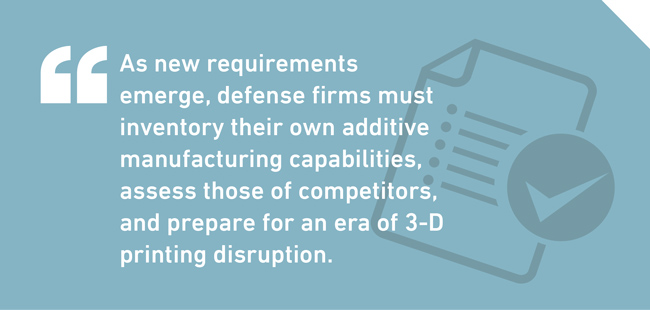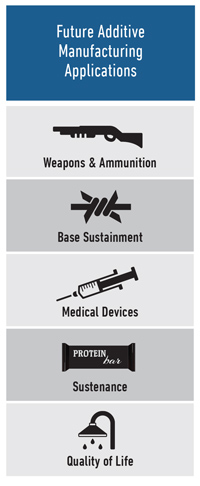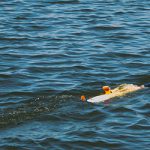Drones On Demand: Additive Manufacturing and the Future Battlefield
Additive manufacturing has the potential to disrupt the defense industrial landscape and revolutionize the ways in which militaries equip and supply. Defense firms must actively prepare for growing “on demand” manufacturing expectations.
A Battery Commander looks down at his gloved hand, examining a cracked M777 tilt knob presented to him by his maintenance mechanic. He shivers as an arctic wind whips across the frozen terrain—a reminder of his unit’s remote position at a forward operating base on the Russian-Ukrainian border.
An impending snowstorm has disrupted supply lines, further isolating his gun line. With the Battery headquarters and sustainment tail several kilometers away, his firing platoon has relied solely on airlift to continue providing 24/7 counter-fire operations.
The cracked four-inch knob – a casualty of sub-zero temperatures and the unit’s relentless operational tempo – renders the howitzer non-mission capable. The Battery Commander, needing a fully-restored gun line in the event of supporting fires, assigns a senior NCO to oversee the repair.
Ducking into the makeshift tactical operations center located in an abandoned bus depot, she quickly scans existing CAD files on her ruggedized laptop to locate the component piece. She connects to the Battery’s on-site 3-D printer, and hits “print.” Within hours, a replacement composite tilt knob is installed; the howitzer is back in the fight.
Additive manufacturing, more commonly referred to as “3-D printing”, is one of several emerging technologies with the potential to revolutionize the ways in which militaries equip, supply, and support their troops. It is also likely to disrupt the defense industrial landscape, creating opportunities and challenges for traditional defense companies while giving niche providers unprecedented chances to break into the market.
Unlike conventional manufacturing techniques (e.g. precision machining, welding, carving), 3-D printing creates objects from the ground-up, applying successive layers of materials on top of one another under varying degrees of heat. 3-D printing in commercial manufacturing has taken off, especially in the aerospace, automotive, and medical sectors. It remained relatively inchoate within the defense sector, until now.

U.S. military experimentation with additive manufacturing—such as the ability to rapidly create cost-efficient prototypes, reduce the footprint of forward-deployed units, improve parts availability, and empower end-users to produce and repair a wide-range of supplies “on-demand” and in-theatre – is gaining traction at the highest levels.
Additive manufacturing is rapidly changing the military’s expectations of what the private sector can do at a critical time for the Defense Department. Each of the armed services must balance their role in ongoing low-intensity conflict campaigns with renewed preparation for regional or potentially global-scale conventional warfare with near-peer nations.
Defense companies anticipating this shift are already investing in their own 3-D printing capabilities; however, it is important that industry appreciate and consider the far-reaching implications that additive manufacturing is likely to have on the industrial base as well as within each of the services.
Current service-driven initiatives largely pertain to reducing logistics supply chains and manufacturing obsolete parts, but these will evolve as technology matures and as new requirements emerge.
However, defense firms should not wait for the development of requirements before initiating preparatory measures. In order to position for and ultimately shape future demand, defense firms must inventory their own additive manufacturing capabilities, assess those of competitors, and prepare for an era of 3-D printing disruption.
Fab Labs: A Growing Appetite for Additive
The growing number of 3-D printing initiatives across the DoD is evidence of a strong appetite for innovative manufacturing techniques to address a changing strategic environment and emergent operational concepts.
Many of the recent initiatives carried out by organizations such as the Army Research Lab, Army Aviation Research Development and Engineering Center (AMRDEC), Air Force Research Lab, Office of Naval Research, Naval Surface Warfare Center Dahlgren Division, Defense Advanced Research Projects Adency (DARPA), and a handful of others can be organized into four broad categories:

3-D Printing & Tomorrow’s Battlefield
 3-D printing stands out among today’s emerging technologies for its potential defense applications. One of the greatest benefits that could substantially improve and transform the acquisition process is the shortening of time it takes to develop technology and field it.
3-D printing stands out among today’s emerging technologies for its potential defense applications. One of the greatest benefits that could substantially improve and transform the acquisition process is the shortening of time it takes to develop technology and field it.
Beyond the discreet development of 3-D printing itself, current initiatives show that the future impact on the acquisition process could be profound.
Rapidly transitioning technology demonstrator prototypes into the testing and evaluation phase could expedite interactions between end-users, the science and technology (S&T) community, and acquisition personnel.
Rapidly transitioning technology demonstrator prototypes into the testing and evaluation phase could expedite interactions between end-users, the S&T community, and acquisition personnel.
In addition to getting capabilities into the hands of warfighters earlier in the acquisition cycle, new potential uses will emerge:
Weapons & Ammunition
The ability to print consumables such as rifle rounds, magazines, and eventually caseless ammunition as well as mission-critical components for weapons platforms is likely to be highly valued in the event of supply-line disruption or unconventional warfare.
Base Sustainment
Forward-deployed units would benefit from the ability to print practical objects such as mouse traps and door hinges, but could use the same 3-D printer to manufacture locks or Concertina wire to build a greater defense-in-depth and reinforce base security.
Medical Devices
Deployable 3-D printers could enhance a unit’s ability to perform prolonged fieldcare, especially in remote, austere environments; potential items include hemorrhage control products (e.g. tourniquets, matrix packing gauze), IV catheters, saline locks, hypodermic needles, chest seals, nasopharyngeal and endotracheal tubes, and minor surgical instruments.
Sustenance
A 3-D printer stationed at a forward operating base could be used to print calorie-dense nutrition bars, which could then be used to fuel expeditionary units on patrol or for Humanitarian Assistance, Disaster Response (HADR) missions.
Quality of Life
In addition to numerous practical applications, field-deployed 3-D printers could satisfy ad hoc, unforeseen hy-giene and basic “quality of life” needs such as shower nozzles, spider traps, or plastic floor mats for swampy or sandy environments to improve living circumstances and boost morale.
Beware the Hype…
The next generation of industry employers will view additive manufacturing as one tool, among many, at their disposal.
Despite the expansive set of capabilities that it may yield, additive manufacturing is by no means a “silver bullet”—it will not replace traditional manufacturing techniques overnight, nor will it obviate supply lines. As industry and government explore the many benefits of 3-D printing, it is important to examine barriers to adoption and also consider commercial sector approaches that may offer insight into these potential challenges.
Potential Challenges
Achieving Scale/Volume
Given its relatively nascent technological state, additive manufacturing has largely been successful within the defense industry printing “one-off” objects as opposed to high-volume production. Although there are certain benefits that can be realized without achieving scale – for example, 3-D printing molds can be used for injection molding – reliable high-volume production would be necessary to print consumables such as bullets or nutrition bars. Researchers at Columbia University are experimenting with printing food, while NASA is considering using printed food for missions to Mars.
Intellectual Property Rights
One of the main concerns surrounding the proliferation of 3-D printing within the defense sector is the loss of intellectual property. Aside from the security concerns, this is a financial matter too. Defense companies especially invest heavily in R&D and absorb non-recurring engineering expenses to develop cutting-edge solutions; therefore, the potential commoditization of hard-won intellectual property could deter some defense firms. More far reaching, it may require evolving industry business models and government contracting practices. 3-D printing research centers are currently developing processors that allow users to print objects without having access to raw files, thereby protecting intellectual property from theft or corruption.
Airworthiness Certification
In order to integrate 3-D-printed parts on airborne platforms, a substantial amount of testing will be required to determine the effects of extreme temperatures, speeds, and altitudes. While smaller, non flight-critical components such as tubing, paneling materials, and titanium parts have already been incorporated into aircraft and aircraft engines, manufacturing larger structures such as wings, rotor blades, or pylons still requires sufficient testing.[1] Some 3-D printed titanium parts have been approved by the FAA and are being integrated as structural components in new commercial airliners to bring down raw material and labor costs.
Quality Assurance & Repeatability
The need for production accuracy, uniform standards, and high-fidelity repeatability of parts are additional barriers to widespread, immediate adoption. This is especially challenging given the defense sector’s varied standards and the speed with which some products will need to be fielded. Given the low risk tolerance for equipment failure, the need for interoperability with allied forces, and the expectation that mission-critical equipment function in a wide variety of climates and geographies, institutional approaches to testing will need to change. To improve quality assurance, organizations such Sigma Labs – a spin-out of Los Alamos National Laboratory – have started to develop quality control hardware and software for powder bed metal 3-D printing processes.
Cost of Materials
While one of the advertised benefits of additive manufacturing is reduced costs (e.g. transportation and storage, labor, prototyping), the price of raw materials for 3-D printing is still relatively high. For companies seeking to manufacture larger parts such as vehicle doors or fuselage sections, the high cost of materials may diminish the efficiencies of using additive manufacturing. Commercial firms such as 3-DEO are developing new additive manufacturing techniques such as Intelligent Layering that aims to reduce the cost of metal 3-D printing.
Cultural ‘Buy-In’
3-D printing has been in development for 20+ years; however, the relative youth of additive manufacturing within the defense industry will likely give rise to naysayers. At the same time, however, the next-generation of industry employers will view additive manufacturing as one tool, among many, at their disposal. This will require reconciling tensions between those concerned that widespread 3-D printing adoption will cost traditional manufacturing jobs. Additionally, in order to quell concerns about performance, defense companies seeking to increase their use of additive manufacturing should be prepared to offer demonstrations as a means of building fidelity in the technical approach.

…But Be Prepared
Interest in 3-D printing will only grow, and the recent release of a DoD Additive Manufacturing Roadmap [2] serves as a harbinger of developments to come. The rise of additive manufacturing within the defense sector will have four important implications for defense firms:
Influx of non-OEM and Commercial Players:
Rapid growth of the commercial 3-D printing industry has created a competitive ecosystem of firms, several of which may choose to pivot into the defense market due to DoD demand or by taking new avenues open to non-traditional defense suppliers.
Traditional defense providers should prepare for the diversification of the supply base and the entry of non-traditional players such as commercial firms or niche, non-OEM suppliers. Defense companies can proactively form strategic partnerships with leading additive manufacturing firms or use existing venture capital arms to acquire smaller firms to bolster internal capabilities.
Gradual Shift in IP Ownership Paradigm:
The model governing the ownership and distribution of intellectual property is likely to change, either through deliberate evolution of legal and contractual norms or due to piracy and copying. Several DoD agencies have already demonstrated heightened expectations for the sharing of IP in order to perform maintenance activities and install system upgrades independent of OEMs.
Defense firms seeking to protect their IP investment while simultaneously meeting new DoD demands can position themselves as innovators within this space and propose forward-looking solutions amenable to both industry as well as government.
Military Parts Certification:
The DoD’s process for certifying parts and approving components for in-flight use will have to evolve as additive manufacturing becomes more mainstream within the defense industry. This will require process optimization within the DoD, but is also dependent upon technological advancements in the accuracy and repeatability of 3-D printed components.
Existing collaboration between military and civil agencies to address the challenges in 3-D parts qualification and certification processes [3] suggests that future changes to existing certification regulations may be inspired by the collective experience of numerous agencies – both civil and military – as opposed to a single authority.
Customer In-Sourcing:
DoD S&T entities, including the Army Research Lab, Office of Naval Research, DARPA, and the Air Force Research Lab, have made substantial strides in additive manufacturing research and development. The development of robust 3-D printing capabilities within DoD labs and S&T organizations may drive the armed services to in-source to curb costs, thereby turning the DoD customer into a competitor.
While there is already some evidence of this trend [4], industry can reinforce its relationships with DoD entities by engaging more closely with the S&T community through partnerships or cooperative R&D agreements (CRADA).
Additionally, defense companies can evaluate pre-existing capabilities across the DoD and conduct a gap analysis which can then be used to inform investment decisions, thereby creating natural partnership opportunities.
Towards a New Manufacturing Model
Additive manufacturing has gained momentum within the past 20 years as technology – mostly led by the commercial sector – has improved and advocates within the DoD have emerged. The appetite for “on demand” production capabilities will grow within the DoD as operational concepts increasingly emphasize mobility and maneuverability, maintaining a light footprint, and ensuring rapid response capabilities.
Near-term demand for 3-D printed parts and components is likely to focus on rapid prototyping and repairing or replacing obsolete parts; however, the maturation of additive manufacturing technologies will spur a re-imagination of the realm of the possible. Future applications are likely to encompass operational necessities, such as ammunition and food, as well as creature comforts that enhance the quality of deployments.
However, additive manufacturing will not be adopted overnight, nor will it supplant traditional manufacturing. Challenges, such as the security and ownership of intellectual property, will at first inhibit immediate and widespread adoption by the DoD before mitigation strategies are formalized and disseminated—likely by commercial industry, which has already made strides in improving print quality, lowering raw material costs, and developing IP protection measures.
The evolution of manufacturing methods within the defense sector and changing DoD expectations will have significant implications for defense firms. Growing interest in 3-D printing to shorten the acquisition cycle and field capabilities is likely to incentivize new firms to enter the DoD marketplace, resulting in a more contested ecosystem of providers.
Additionally, traditional intellectual property regimes will be forced to change to accommodate printing at the point of need. Yet, the relative youth of DoD 3-D printing initiatives highlights the substantial opportunities for defense companies to get ahead of the additive manufacturing trend and ultimately shape its development.
Taking proactive steps, such as partnering with S&T entities to build relationships, forming strategic alliances with commercial firms, and investing in thought leadership are ways in which defense firms can position for future growth in a rapidly changing operational environment.






